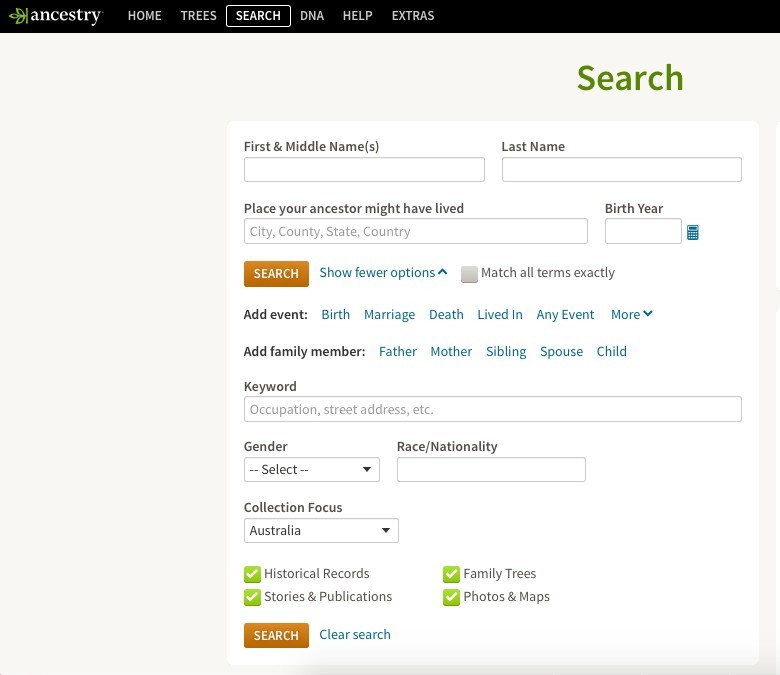 Ancestry.com is a genealogy website that millions of people worldwide use to research their family
history every day. The site holds billions of records and continues to add more searchable content every day. This means that just because you couldn't find your ancestor last year there is always a possibility the record has been added since. It's just a case of checking back regularly. Ancestry offers you not only the facility to search records worldwide but you can build your own tree using their website. There is also the facility to connect with people who are also researching the same ancestors as you. For those who want an extra level of confirmation of their heritage, they offer DNA testing to confirm where your ancestors came from. They then put this into a database for people to connect through similar DNA patterns. I have connected with numerous people in Australia, England, and the USA who are distant cousins just using the tree search and message facility.
Ancestry.com is a genealogy website that millions of people worldwide use to research their family
history every day. The site holds billions of records and continues to add more searchable content every day. This means that just because you couldn't find your ancestor last year there is always a possibility the record has been added since. It's just a case of checking back regularly. Ancestry offers you not only the facility to search records worldwide but you can build your own tree using their website. There is also the facility to connect with people who are also researching the same ancestors as you. For those who want an extra level of confirmation of their heritage, they offer DNA testing to confirm where your ancestors came from. They then put this into a database for people to connect through similar DNA patterns. I have connected with numerous people in Australia, England, and the USA who are distant cousins just using the tree search and message facility.
Step 1
The first thing to do is join Ancestry.com and signup for a free 14-day trial. This reverts to a paid subscription if you are happy with your experience and don't cancel prior to the end of the trial. They offer monthly, six-montly and yearly subscriptions of varying levels of access to content such as: UK Heritage - This is a lower-level subscription that gives you access to UK census and vital records and key Australian Records UK Heritage Plus - This is a mid-level subscription that gives you access to all Australian, NZ, Ireland and UK records including UK Parish records, and critical UK Military records
World Heritage - This is high-level subscription that gives you access to all Australian and UK records, Worldwide immigration records, and records from NZ, USA, Canada and more.
US Discovery - This is a lower-level subscription that gives you access to all US records
World Explorer - This is high-level subscription that gives you access to all US and International records
As you can see there is aa subscription to suit everyone depending on your needs. Obviously if you live in Australia and don't have any US connections it would be counter-productive to get the US Discovery access. You would be better suited to the UK Heritage, UK Heritage Plus or World Heritage options. Ancestry have these different subscriptions in an easy to view table to make the right choice for you.
UK Heritage Plus - This is a mid-level subscription that gives you access to all Australian, NZ, Ireland and UK records including UK Parish records, and critical UK Military records
World Heritage - This is high-level subscription that gives you access to all Australian and UK records, Worldwide immigration records, and records from NZ, USA, Canada and more.
US Discovery - This is a lower-level subscription that gives you access to all US records
World Explorer - This is high-level subscription that gives you access to all US and International records
As you can see there is aa subscription to suit everyone depending on your needs. Obviously if you live in Australia and don't have any US connections it would be counter-productive to get the US Discovery access. You would be better suited to the UK Heritage, UK Heritage Plus or World Heritage options. Ancestry have these different subscriptions in an easy to view table to make the right choice for you.
Step 2
You are now ready to find ancestors. Upon logging in you will notice a menu across the top of your screen that has Home, Trees, Search, DNA, Help and Extras - see the picture. At this stage you are really only interested in Trees and Search. First click on Trees and Create a New Tree and give your tree a name. This is where you enter the basic information that you know - you, your parents, siblings, aunts, uncles, cousins, grandparents. Just start the tree with what you know - you may be surprised at just how much you do know. You can choose to set your tree as public or private. If you choose public it becomes searchable in the tree database. This means others can find your tree and connect with you. If you set it to private you can invite people to view or edit it but it won't be available in the search engines. Fortunately there is an automatic process in building trees that sees anybody who is living has their details automatically hidden so only you can see them.
First click on Trees and Create a New Tree and give your tree a name. This is where you enter the basic information that you know - you, your parents, siblings, aunts, uncles, cousins, grandparents. Just start the tree with what you know - you may be surprised at just how much you do know. You can choose to set your tree as public or private. If you choose public it becomes searchable in the tree database. This means others can find your tree and connect with you. If you set it to private you can invite people to view or edit it but it won't be available in the search engines. Fortunately there is an automatic process in building trees that sees anybody who is living has their details automatically hidden so only you can see them.
Step 3
 Now head to Search to start filling in the gaps and find your ancestors. Ancestry records are older, that is, records, where the person is likely to be still alive, will, more than likely, not exist on the site. This is the same for most genealogy search engines. That said, you can find records such as Australian Electoral Rolls that are more recent as these are a publicly available record. More than likely though you will be searching for people older than your grandparents so it shouldn't pose too much of an issue.
Now is where the search and tree function comes into its own. Fill in as much information as you know into the search engine. You can set year ranges for example 1890 +/- 5 years will search 1885-1895. You can set just a country e.g. England, narrow it down to a region e.g. Staffordshire, England, or narrow it even further to a specific location e.g. Willenhall, Staffordshire, England. The more information you have going in the easier it is to narrow the search parameters down. When you find a record you can link it to your tree, however, this is where you need to be discerning.
Now head to Search to start filling in the gaps and find your ancestors. Ancestry records are older, that is, records, where the person is likely to be still alive, will, more than likely, not exist on the site. This is the same for most genealogy search engines. That said, you can find records such as Australian Electoral Rolls that are more recent as these are a publicly available record. More than likely though you will be searching for people older than your grandparents so it shouldn't pose too much of an issue.
Now is where the search and tree function comes into its own. Fill in as much information as you know into the search engine. You can set year ranges for example 1890 +/- 5 years will search 1885-1895. You can set just a country e.g. England, narrow it down to a region e.g. Staffordshire, England, or narrow it even further to a specific location e.g. Willenhall, Staffordshire, England. The more information you have going in the easier it is to narrow the search parameters down. When you find a record you can link it to your tree, however, this is where you need to be discerning.
Be Careful
Just because you find a record for John Smith, born 1911, in Queensland does not mean it is your John Smith. You need to gather your information carefully, cross-referencing all the information you know. Many people make the mistake of just attaching the first record they come across. I have come across many trees on Ancestry where people have not checked their information and attached the wrong person to their tree. One example I have seen is someone who shares a great uncle with me from Perth, Western Australia who attached him to a marriage record of someone with the same name in New South Wales. This snowballed to the point they linked him to numerous children as well. The biggest issue was this great uncle had died two years previously in Western Australia. So please check, double check, and triple check everything before adding people to your tree. Sometimes it's preferable to make a note of similar records and hold off until you know more about that family.Step 4
 Ensure you keep a record of what you have searched already. You can do this using a notebook and pen or by using your computer. I also download any documents I find in Ancestry to my computer into organised folders because even when you have them on your tree if you cancel your subscription you can no longer access these documents. This is why I prefer to use a compute software program called Family Tree Maker that can sync your online tree with the software program. I will talk more about filing and computer software another time.
So now you have a basic understanding of Ancestry.com you are ready to start your family genealogy journey. Enjoy!
Ensure you keep a record of what you have searched already. You can do this using a notebook and pen or by using your computer. I also download any documents I find in Ancestry to my computer into organised folders because even when you have them on your tree if you cancel your subscription you can no longer access these documents. This is why I prefer to use a compute software program called Family Tree Maker that can sync your online tree with the software program. I will talk more about filing and computer software another time.
So now you have a basic understanding of Ancestry.com you are ready to start your family genealogy journey. Enjoy!

This looks fun. My grandmother always hinted that we had a couple famous ancestors but never really delved deeper – I think I’ll take a look.
I do know my father – mostly US (Anglo, French ancestry) and my mother (Czech with German and Austrian heritage) should come up with some interesting info.
Do you know if they do any DNA stuff? Can I send in a sample and have that used to verify / trace?
Hi Ben, thank you for taking the time to visit my blog. Ancestry.com certainly do DNA testing and give you a breakdown of your ancestral heritage. It then goes into their database and matches you with relatives. Yours would certainly be interesting with the backgrounds of your family. So far I’ve traced my mother’s heritage to from Australia to England, Scotland and Wales. Dad was born in England and so far his family has been in the one region for generation after generation. I would love something a bit different, like you, to get my teeth into. Happy searching.
Hi Megan,
This is a great article, I am an Aussie too with an Irish background. My great grandparents settling in a small town on the far south coast of NSW. We all have a great sense of pride in where we come from and our Ancestry. I have visited this town and my families influence in this town left me in tears. There Is no prouder Aussie than me, but I love the fact that Irish blood runs through my veins. I can’t wait to check this site out and learn a little bit more about how wild I am haha
Thanks so much mate
Paul
Thank you for visiting my site Paul! Where we come from is so important. I unfortunately haven’t found any Irish roots in my family. Dad is from Staffordshire and so far his family has only ever been in Staffordshire. Mum is Australian descended from a convict with strong English and Scottish roots and an outlier from Wales. It’s so interesting finding out about my family’s heritage. So great you’ve been able to get back to the town he is from. I am hoping to do a trip to the UK in the coming years and see where my family came from. I hope I’ve ignited your passion for genealogy!
I wish my great-grandmother and grandmother were still here for me to ask these questions. I’ve always been too afraid to do this. I don’t know why.
Hello Lane
It is always sad when we realise the wealth of information about our family has gone from the older generations passing. However, if you can find old photos, diaries, cards, letters, documents you will be surprised at the information that can be gathered. If you need help please contact me.
Regards,
Megan